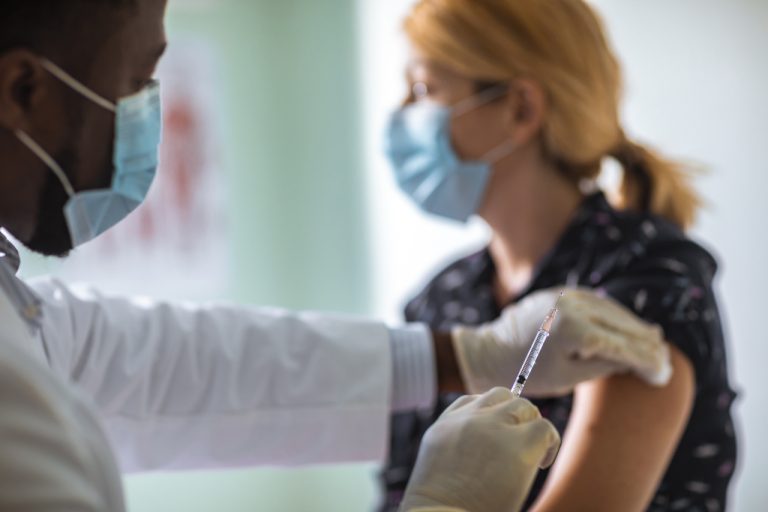Story Highlights
- It has been reported that women are at greater risk for anaphylactic adverse reactions to the experimental vaccines for COVID-19 compared with men.
- In the first month of vaccination with both the Pfizer/BioNTech and the Moderna vaccines, almost all of the potentially life-threatening anaphylactic reactions occurred in women (44 of 47 in the Pfizer group and 19 of 19 (100 percent) in the Moderna group, which only included the first round of shots.
- The differences in reactions to vaccination between males and females has been reported for other vaccines as well, and reflects critical sex-linked differences in general immune system responses in humans.
Women are reportedly at greater risk of experiencing side effects from the experimental COVID-19 vaccines compared with men.1 2 The U.S. Centers for Disease Control and Prevention (CDC) looked at the breakdown of adverse reactions reported in the first month following the granting of an Emergency Use Authorization (EUA) by the U.S. Food and Drug Administration (FDA) for distribution of Pfizer/BioNTech and Moderna COVID-19 vaccines.
The CDC evaluation used reports to the Vaccine Adverse Event Reporting System (VAERS) and V-safe, the CDC’s new monitoring system that was created exclusively for the COVID-19 vaccination program. CDC officials forwarded COVID-19 vaccine adverse reactions reported via the V-safe system to VAERS if officials considered the events to be “clinically indicated.”
During the study period (Dec. 14, 2020 – Jan. 13, 2021) 13,794,904 COVID-19 vaccines were given. A total of 6,994 adverse reactions were reported to VAERS (6,354 classified as non-serious and 640 as serious events). Though 8,436,863 (61.2 percent) doses were given to women, 5,505 (78.7 percent) of the reported reactions occurred in women, compared with 1,408 (20.1 percent) in men.3
The incidence of reactions was higher after the second dose of the Pfizer vaccine compared to the first dose. For symptoms such as fever and chills, the rate of reported incidents was more than four times higher after the second dose compared to the first dose. Timing of the study precluded inclusion of side effects following the second dose of Moderna’s vaccine. As data are updated to include those numbers, rates of reported COVID-19 vaccine adverse events would be expected to change.
This same trend is echoed in the number of potentially life-threatening anaphylactic reactions reported to VAERS for the two vaccines. Between Dec. 14 and Jan. 18, 2021, 47 anaphylactic reactions were reported in the Pfizer/BioNTech group, and 44 (94 percent) of COVID-19 vaccine reactions were in women. In the Moderna group, all 19 reported vaccine reactions were in women (100 percent).4
Men and Women Are Known to Respond Differently to Vaccination
Sabra Klein, a microbiologist and immunologist at the Johns Hopkins Bloomberg School of Public Health was not surprised by the gender variance, noting that the differences have been seen with other vaccines as well. Julianne Gee, a medical officer in the CDC’s Immunization Safety Office and corresponding author of the CDC’s COVID-19 vaccine response study, pointed out that females are known to express increased reactivity to a number of vaccines, including adult influenza vaccines, as well as some childhood vaccines, such as the hepatitis B and measles, mumps and rubella (MMR) vaccines.5
In 2009, a study of the H1N1 vaccine reported a hypersensitivity rate of 10.8 per million persons. Results showed that, “Females of childbearing age had higher rates of allergic reactions than males,” while rates in other age groups were similar.6 Their results were based on VAERS reports, and the researchers speculated both that under-reporting of milder symptoms could have resulted in an underestimation of the total number of reactions and, further, that the results might have reflected a selectively greater incidence of reporting among women.
That potential for behavioral differences leading to greater reporting of vaccine adverse reactions by women compared with men was also raised by researchers in the CDC’s study.7 However, it is stressed that biological differences between women and men y also plays a role. According to Eleanor Fish, an immunologist at the University of Toronto, “The female immune response is distinct, in many ways, from the male immune response.”
Gender Dictates Both Response to Infection and Vaccination
Several sex-linked attributes are involved in the different immune responses of males and females, whether to vaccination or to natural infection. Females, for example, may produce as many as double the number of antibodies following vaccination for influenza, MMR, yellow fever, rabies and hepatitis A and B, as well as greater numbers of T cells, the white blood cells that recognize and eliminate invading pathogens.8
In general, the reproductive hormones estrogen, progesterone and testosterone are also known to bind to immune cells and influence their behavior. Estrogen (female hormone) can increase the production of antibodies, while testosterone (a male hormone) is more immunosuppressive. The differences in immune response between males and females are most pronounced in young adulthood, lending credibility to the role of reproductive hormones.9
Males Have Higher Chance of Developing Severe Illness, Dying from COVID-19
A Yale study looked at the considerable sex-linked differences in immune system responses to viral or other pathogenic challenges and offered some possible biological reasons why men have a higher chance of developing severe illness and dying from infection with SARS-CoV-2, the virus that causes COVID-19, compared with women.10 This “male bias” in COVID-19 mortality has been observed in most countries where data are broken down by sex, with the risk of death in males approximated at 1.7 times higher than in females.11
Animal studies have commonly observed that male sex is more often associated with lower immune responses and higher susceptibility to infections compared to females. The same patterns are also seen in human patients: Males tend to exhibit higher viral loads for infections including hepatitis B and HIV. On the other hand, the immune response to vaccines, such as influenza vaccines, is often stronger in females.12 Such heightened immune responses may explain why autoimmune diseases occur so much more commonly among women (80 percent) compared with men.13
Male and Female Immune Responses Differ
While several sex-linked immune system factors are at play, (the differences in immune and cytokine responses for example), the roles of sex chromosomes themselves, as well as sex hormones are important contributors. A number of immune-related genes are encoded on the X chromosome,14 and sex hormones have been shown to modulate several immune system responses.
Animal models have demonstrated that estrogen (female hormone) modulates the expression of angiotensin-converting enzyme 2 (ACE-2), the entry receptor cell for SARS-CoV-2, which causes COVID-19. Estradiol, a form of estrogen, also has been shown to reduce the production of inflammatory cytokines. At the same time, androgen-deprivation (as used in treatment of prostate cancer) appears to reduce the risk for SARS-CoV-2 infection. Like estrogen, androgen (male hormone) has been shown to be generally immunosuppressive.15
Researchers Identify Female Susceptibility to COVID-19 Vaccine Reactions
In agreement with these findings, the Yale researchers identified several specific sex-linked immune system differences that can impact on male susceptibility to severe COVID-19, as well as to female heightened reactivity to COVID-19 vaccination. One of their findings was that women tended to mount a stronger T-cell response to infection in general. In contrast, men in the early stages of COVID-19 infection showed higher levels of cytokines, inflammatory proteins involved in the “first response” to invading pathogens.
Cytokines work by creating inflammation in infected tissue, which serves as a physical barrier to an infecting organism. In COVID-19, the so-called “cytokine storm” associated with severe disease is representative of an overactive cytokine reaction that causes fluid to build up in the lungs, and its associated symptoms include shock, tissue damage and multiple organ failure.
Finally, size of the vaccine dose was not considered in evaluating the greater hypersensitivity among women, despite evidence that women absorb and metabolize drugs differently from men and may need lower doses. Although drug and vaccine trials now include women, clinical trials of the COVID-19 vaccines did not test whether lower doses might be effective in women with fewer side effects.16
Many questions remain about how gender impacts immune system reactions, both to vaccination and to infection in general. Little is known, for example, about the immune response differences of those who do not fall neatly into male or female gender designations.17 As voiced by the Yale researchers, there seems to be some agreement that, “researchers racing to develop treatments and vaccines should consider separate strategies for women and men so that everyone can benefit.”18
If you would like to receive an e-mail notice of the most recent articles published in The Vaccine Reaction each week, click here.
Click here to view References:2 Gee J, Marquez P, Su J, et al. First Month of COVID-19 Vaccine Safety Monitoring — United States, December 14, 2020–January 13, 2021. MMWR Feb. 26, 2021.
3 Ibid.
4 Ibid.
5 Ibid.
6 Halsey NA, Griffioen M et al. Immediate Hypersensitivity Reactions Following Monovalent 2009 Pandemic Influenza A (H1N1) Vaccines: Reports To VAERS. Vaccine Dec. 9, 2013.
7 Wenner Moyer M. Women Report Worse Side Effects After a Covid Vaccine. The New York Times Mar. 8, 2021.
8 Ibid.
9 Ibid.
10 Harrison R. Sex Differences In COVID-19 Immune Responses Affect Patient Outcomes. Yale News Aug. 26, 2020.
11 Takahashi T, Iwasaki A. Sex Differences In Immune Responses. Science Jan. 22, 2021.
12 Ibid.
13 Angum F, Khan T, et al. The Prevalence of Autoimmune Disorders in Women: A Narrative Review. Curus May, 2020.
14 Takahashi T, Iwasaki A. Sex Differences In Immune Responses. Science Jan. 22, 2021.
15 Ibid.
16 Wenner Moyer M. Women Report Worse Side Effects After a Covid Vaccine. The New York Times Mar. 8, 2021.
17 Takahashi T, Iwasaki A. Sex Differences In Immune Responses. Science Jan. 22, 2021.
18 Harrison R. Sex Differences In COVID-19 Immune Responses Affect Patient Outcomes. Yale News Aug. 26, 2020.














9 Responses
So instead of making a horrible vaccine why don’t they make a Cytokines blocker to prevent the inflammation from starting.
All these finding may or may not be true. With a voluntary reporting systems such as VAERs, there may be a great portion of reaction instances that do not get reported and are not included in the data. Since this reporting system has been in use for quite a while, in my view the vast majority of negative reactions to vaccines have never seen he light of day as far as being incorporated in any statistical studies. Because pharma is always severely squelching any and all “anti-vaccine” data, opinions, fact or general discussion…what are they hiding? If vaccines are so great, let the truth speak from all corners of the world without suppression.
It’s not “vaccination” by definition. It is “experimental gene therapy” approved for emergency use only.
It’s not even what you can call ‘therapy’ because that would mean there could be potential benefits to this ‘treatment’ It is more gene manipulation.
Listening only to mainstream evening news reports (CNN & MSNBC for ex.), you wouldn’t have any idea that a negative reaction to these vaccines has ever occurred. How can we protect those most susceptible to vaccine reactions if there is no acknowledging that there have been vaccine reactions to the COVID vaccines, including fatalities?
So many people are unfortunately very naive and truly believe that big pharma is only looking out for the good of humanity. It is extremely difficult to convince them otherwise.
I second your sentiment.
As I suspected, something was very wrong with the HPV Vaccines and the way they were pushed into women and girls. I suspect this is part of that agenda. In Bill Gates own words. If we do a really good job with vaccines we can reduce the population by at least 15 million. With the gene manipulation technology currently available the size difference per kg and the difference between men and women perhaps even the population variation the fact that women out number men in most global location. This makes. Logical sense.
This seems to be an extension to the depopulation Agenda tarted with HPV vaccines. Just another way of depopulation. However, more specifically structured . Reading the fact sheets for Moderna, Pfizer, Johnston and Johnston and Astra Zeneca. They all have common things written and actions with Adenoviruses used . Experimental vaccines. I would not say they are treatments. Or Vaccines Now that David Asher revealed what took place in Wuhan and with other information I read from other sources. It falls into place as a huge crime against humanity more then trying to help humans survive. This plandemic.